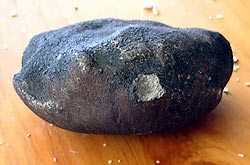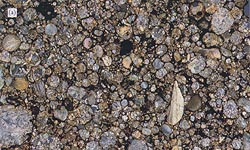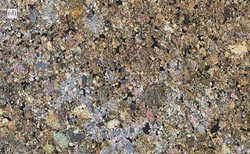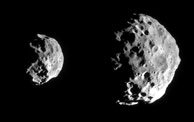|
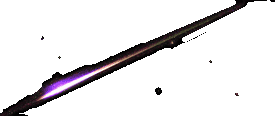 |
Most of our knowledge of the outer universe and of our own sun comes from spectrographic analysis of optical, radio and radar wavelength emissions. We have first hand data from a few hundred samples collected from the moon during the Apollo "flights" and some automated analysis in situ of the moon and of Mars. For the rest of the solar system we have to rely on meteorites, small fragments of rock ejected from a planetary surface when impacted by a larger primary meteorite. Incredibly, after a few million years floating about in inner space, some of these chunks come within the Earths gravitational field and crash onto the surface, some surviving almost intact. The collection of 27,500 new meteorite fragments lying on the ice of Antarctica and a resurgence of collecting from desert areas where they are both better preserved and more visible, has greatly increased our knowledge of the composition of both some of the other planets and of the possible primary material of which the planets are formed. Meteorites range in composition from pure nickel-iron to pure silicate though the latter also usually contain 20-30% of FeO. Of the silicate, "basaltic" or "stony" meteorites a special group are the "Chondrites" formed of a conglomerate of small spherules of primary atomic accretions now containing mainly olivine, enstatite or rarely plagioclase microlites in a matrix which can vary from similar silicate material to included droplets pure metallic iron. The carbonaceous chondrites include complex carbon molecules which may have been the origin of life forms. For the descriptions, pix, thin sections and intelligent discussion on meteorites, many commercial web sites are outstanding. We especially recommend M Richard et Roland Pelisson of www.SaharaMet.com and the New England Meteorite Services at www.Meteorlab.com.
The high alumina group at ~5% MgO and 28-30% Al2O3 are lunar anorthositic breccias, with some scattered representatives of high iron Mare basalts. The cluster of ~17-20% FeO at ~7% MgO are the eucrites assumed to be derived from the planetoid Vesta. With decreasing CaO they grade through the Howardites to the orthopyronene-rich diogenites. Less evolved than the eucrites are the Martian meteorites with an average at 13.6% MgO of 6.5% Al2O3, 19.2% FeO, 8.4% CaO and 1.1% Na2O. Only Lunar and Martian rocks and achondritic meteorites seems to have undergone partial melting as they show several different ratios of La/Sm, Zr/Nb etc. The chondrites and HED ( ie, the howardites, eucrites and diogenites) show little chemical change in residual element ratios such as La/Lu or Zr/Nb throughout though the HEDs can be very coarse grained. Any fractional crystalisation within the HEDs must have involved only plagioclase, olivine, orthopyroxene which do not affect these ratios, however there remain many minor groups to be looked at in detail, and the amount of data is extremely minimal for some types of meteorite.
The Chondritic Meteorites Once we have excluded the lunar meteorites, the Martian SNC’s, the HED’s and an array of magnesian cumulate achondrites with a high percentage of clinoenstatite, Opx, clinopyroxene and olivine including the aubrites, angrites, ureilites and others which are often polymict breccias released from deep in a planetoid by impact, we are left with little but chondrites. The chondrites are an interesting group. The Dar al Ghani carbonaceous chondrite shown above, shows in detail what is thought to be the solar system as it was within days of creation. Tightly packed little conglomerations of atoms, still hot enough to weld together and to grow internal high temperature crystals a few hundred microns long, a process quickly brought to a halt after no more than days by chilling. Some chondrules are pea-sized, but most are much smaller. Some seem to be pure enstatite or clinoenstatite, some mainly olivine, and some almost pure anorthite, some include droplets of metallic iron. Olivines and OPX may be in optical continuity showing barred or octohedral or sector zoned characteristics. Whether the origin of the solar system lay in a binary star, one member of which went nova, or whether a passing body dragged a chunk of matter off the surface of the sun after it for a time, or whether some odd internal explosion sent out a jet of material a few hundred million miles into space, does not really matter. Once ejected the solar material of whatever origin was slowed equally by gravity, but the initial explosion may have give greater impetus to the light elements. So it occurs that the most far distant planets have all the gases, H + He, and we can guess, light elements such as Li, Be, B while the inner ones are much heavier. S got as far as Jupiter but Neptune seems to be mainly hydrogen. Mercury has the highest specific gravity, it is assumed to have a very high iron content, but it will be interesting to find out how much Th, U, Pb, and Ta it contains. It has also been speculated that the Sun’s heat drove the gasses to the outer planets but this does not seem likely. The hot gaseous plasma must have been concentrated, were it spread out into a thin rotating sheet as seen in the rings of Saturn, the plasma would quickly chill and amalgamation and welding of chondrules into large masses would not be possible. So we can assume a fairly compact jet or a torus between suns such as astromomers see in distant binary stars. Far from the sun, local excess mass attracted material from further out and also from closer in travelling at different rotational speeds, and the accretionary planetoids began rotating from the beginning, all in the same plane and all with their spin axes normal to the plane of the ecliptic. In the main they still are though some have had their orbits modified by local moons etc, but how Uranus ended up rotating flat in the plane of the ecliptic is anyone’s guess. We can guess that the planetoids and planets did not accrete on the whole by the impact of great masses of meteorite but by the constant inpouring and compaction of the atomic accretions we now see as chondrules, mainly cooled and solidified into cosmic dust either isolated or in loose conglomerations, chondrules which were on the outer regions of the original jet or torus and did not weld to others to form chondrite. Above a critical mass the internal temperature of an accreting planetoid rises to above 1000º C and the chondrule crystallites go on forming, growing larger, extending beyond their former limits and becoming rocks like the diogenites. Partial melting and the formation of lavas has taken place in both the moon and Mars, probably in all the larger planetary bodies, only the eucrites of Vesta seem to have differentiated but still retained the parental chondritic La/Sm and Zr/Nb fingerprints, probably because the formation Opx and plagioclases does not affect the ratio of residual elements such as La/Sm.
The initial planetary formation might have been relatively painless but a billion years or so later one or several unfortunate collisions between a planet and a large planetoid caused very large impactite chunks miles across to be fragmented many of which accreted to larger bodies, of which we can still see the effect in the lunar maria. Did similar sized meteorites impact Earth or Mars? We can see little remaining evidence of it, though all planets have been bombarded by meteorites of modest size in this later era at about 3.7Byr. A few largish meteorites such as Manicouagan or Gosse's Bluff have left scars on the Earths surface. Divisions of Chondrites The chondritites have been subdivided into more than a hundred sub-types based on their petrography. This is not reflected in their chemistry. The major differences lie in the variation in iron content and in their oxidation state. Some may have 25 – 35% FeO, and less than 1% metallic Fe, others may have high metallic iron and low FeO. The most reduced are the “enstatite chondrites” where the main mineral within the chondrules is very magnesian enstatite or clinoenstatite and the total FeO may be <5% while metallic iron may be 20-30%. With increasing iron we have the “L” (low iron) chondrites, the Carbonaceous chondrites which average about 24% FeO, and the “H-Type” high iron chondrites which may have as much as 35%. The data include a great many oddities, including “fusion crusts” which in some cases have elevated iron, “dark inclusions” which usually have elevated REE and these have been rejected where possible. Many people seem to have analysed fusion crusts by EMP as a convenient ready-made glass, but a few minutes or hours in passage through the Earth’s atmosphere at white hot temperatures appears in some cases to have greatly modified their composition. But if we reject ALL analyses of fusion crusts, there will sometimes be little data left! La/Sm In general the ratio La/Sm remains the same, though a little lower in the enstatite chondrites. From separate diagrams we get:
These figures are from samples which have been graphed and most oddities rejected, and based on the arithmetic means of acceptable data. If the impetus of ejection allow a separation of lighter gasses from heavier elements, it is possible some slight separation of LREE and HREE occurred also. The Ce/La ratio is 2.7 with scatter possible due to the low levels and lower precision of data produced in the pre ICPMS era. Zr/Hf This ratio, so constant in terrestrial rocks between 48 and 52, in the chondrites shows considerable scatter averaging 30. There are few data and whether the scatter is due to imprecision of at such low levels, we do not know at this point. The major elements show few correlations , even a dilution effect with iron is not very well marked, being obscured by sample size variation, so that elements such as Ti, Ca, Al, Na, K, simply form clumps at a range of iron levels. Nickel shows a very slight negative correlation with Mg, and a good positive one with Fe as does Co. V is fairly constant near 60 ppm. As metallic Fe is often not determined and as most major elements are done on different aliquots to the trace elements we cannot recalculate to a common FeO. Silica, contrary to terrestrial experience, shows a positive correlation with Mg. Alkaline Earths These generally show Sr > Zr > Ba > Y = Rb > Nb, more enriched that seen in terrestrial NMORBS where usually Y > Ba > Nb > Rb. However, an original chondritic mantle has lost the potassium-group element now found accumulated in continental crust.
Constant Element ratios Throughout the Solar System. Other element pairs may show a constant ratio throughout the entire solar syestem, thus Y/Yb = 10, not only in chondrites, but in HEDs, Lunar, and most Martian and terrestrial rocks. We also find Ho/Er = 3; Ho/Yb = 3; Ho/Tm = 2.5; Gd/Ho = 5; Yb / Lu = 6.66. REE Normalised diagrams These are potentially very useful in distinguishing different parentages, but, as may be seen in the SNC Martian Group, many parentages may be possible, but incomplete data means that nothing positive can be done. Of 500 chondrites analysed for SOME REE, only about 20 have been done for all, and there appears to be exactly one complete set of REE for all the enstatite chondrites. The alternative is to average large groups on their La content. In general, low La rocks have lower La/Sm so we might get something significant. The currently accepted “Standard Chondrite” lies near the low enstatite chondrites, and is about 30 – 40% lower in REE than the mean found here. Notice that the mean coincides with the 0.2 to 0.3ppm La group and that chondrites are more enriched in LREE than most NMORBs. In other words the upper mantle (if once formed of chondrite) must have undergone considerable depletion since before the NMORB rocks of the Archaean were formed. Both alpine peridotite and wehrlite-lherzolite inclusions in alkaline lavas have only 1/3rd the FeO seen in average chondrites but when metallic Fe is removed ( in those samples for which it has been done) we are left with 8% FeO, the same as in Alpine peridotites. Carbonaceous Chondrites Apart from the presence of a few percent of graphite, these seem to have no other differing characteristics. The range in iron is wide, from 0 – 35% FeO but the average as metal is only 2.4% and they are often favoured as a parental material because of the presence of amines in the carbon. It must be pointed out that 99% of planet Earth could be carbon free, and one amine-bearing meteorite arriving after cooling and after oceans and an equable climate was established, could be enough to start the carbon cycle going. However, the high CO2 of the Archaean atmosphere suggests a substantial proportion of carbonaceous chondrites in late arrivals.
Whether this is due to the limited amount of data available 15 years ago, we do not know. It would seem the Chondrite standard should be a mean of all values and the "Parental Mantle" a somewhat depleted version of it. The carbonaceous chondrites show a wide range, eg from 0.58 to 1.55ppm Ce, BUT the ratios La/Sm = 1.7 and Zr/Nb = 15 remain the same as seen in Eucrites and HEDs in general, as well as in the L-Type (=low Fe) and H-Type chondrites. The flat disposition of REE at such depleted levels is never seen in terrestrial rocks. In spite of the fact that terrestrial basalts have not changed in composition in the last 3.5 byr at least, the Earth's mantle has much lower iron, (8% vs ~ 25%) , higher silica, and is more depleted in LILE that the average chondrite. Chondrite Zr/Nb of 15 is equivalent to a terrestrial OIB tholeiite, but contrasts with depleted NMORB which are high degree partial melts with Zr/Nb, of 25 to 100 or more. Enstatite Chondrites Marked by chondrules with enstatite or clinoenstatite, the rocks given this name seem to have highly variable but usually with very low FeO with an average metal content of 20.1% and MgO of 20.1% also. Their initial temperature of formation may have been higher, and in general they are highly reduced. L-Type and H-Type Chondrites These are distinguished on the amount of iron present, L-types having less than 10% and averaging 2.7% however the average total iron as Fe is 21.26% H-Type have an average metal of 14.34% and FeT 26.75% so the difference is mainly one of oxidation potential, other characters being similar.
Low-Fe (reduced) chondrite lies almost on pure magnesian Opx while the more iron-rich cross the more ferriferous olivines. One might suspect that reduced chondrites would first form enstatite and the more FeO-rich would form olivine, and from the chondrite mineral data this appears to be so. The HED = Howardites, Eucrites and Diogenites These quite evolved meteorites are generally thought to have an origin in one of the larger planetoids and spectrographic comparison suggests Vesta, though they are more LILE-enriched than the much larger Mars. They have the highest LREE and LILE content of all meteorites. The mineral separation is extreme, the eucrites being mainly pigeonite-calcic plagioclase and the diogenites mainly orthopyroxene. Eucrites have by far the highest REE-content of any meteorite with up to 6.75 ppm La and 18 Ce. Howardites These are polymict breccias, being mixtures of eucrites and diogenites. Eucrites
Diogenites These are formed of mainly orthopyroxene (up to 1 cm size) and minor olivine with Fs, Fa varying from 21-35%. An average of 62 Diogenites gives SiO2 52.2; 1.38% Al2O3; 16.2% FeO; 26% MgO; 1.56% CaO, 0.07% Na2O. Such rocks are not as yet known from the Terrestrial mantle where FeO appears to be consistently about 8%. Lunar Meteorites
Martian Meteorites
The bulk of the samples are Shergottites, which probably represent the bulk of the Martian unmodified surface, a high iron peridotite with an LILE content ranging from roughly EMORB to NMORB though the shape of the REE distribution is not one commonly seen on Earth, being rather more domed. Two other trends both with elevated relative LREE are seen. The three samples with the lowest HREE at about 0.04 EMORB with La = x .07-x .08 EMORB are Chassignites. The other group with Lu at 0.08 EMORB and La at ~0.4 EMORB are the Nakhlites. Martian Orbits as seen from Earth. More than 2000 years ago Ptolemy at the University of Alexandria, found the only way he could explain the curious paths of planets like Mars, (which seemed to go backwards and forwards in the sky, and then shift further round the sun) was to assume it moved in small circles which rotated about the much large circum terrestrial circle. The major error was to assume the earth was stationary as it seems to the senses to be. A member of clan Gunn, one, Arthur, has computed the paths of the planets with an error of not more than 2 arc-minutes over the next 2000 years. The actual path of Mars relative to the Earth is as shown below. The variation in distance between Earth and Mars is enormous as the distance can vary from the minimal orbital distance, to that plus twice the value for the earth's distance from the sun, when we move round to opposite solar positions, ie from about x solar units to y solar units. See a Solar System Simulation The path described is close to a cardioid, but slight distorted due to the slightly elliptical shapes of the orbits. The program P-Cubed (Planetary Path Program, or/ Solar System Simulation) can compute the position of any planet and some comets for any date.
Terrestrial Comparisons
Orbital Path of Neptune. |__| Neptune being much further from the sun is not so much affected by addition and subtraction of Earths Orbital differences. The minimum and maximum interplanetary differences range from AU to AU. Copyright © 2004-2006 Dr B M Gunn |

